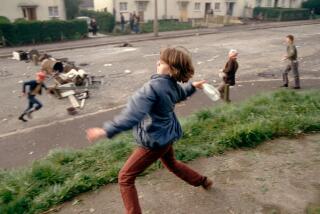Even as Iron Curtain Crumbles, an Irish Curtain Continues to Take Shape in Belfast
- Share via
BELFAST, Northern Ireland — They can be found in a variety of styles and pleasant colors, often on landscaped lawns along with flower beds. They could belong to parks or elegant private estates.
These walls, however, have been erected for a far more serious purpose. They are meant to stop people from killing each other.
They are the “peace lines” of Northern Ireland’s capital, the barriers that for two decades of guerrilla conflict have divided Protestant and Roman Catholic ghettoes.
For most of that time they were high fences of corrugated iron. They were crudely patched up when they rusted or got torn down in the violence between Catholic nationalists seeking unity with Ireland and Protestants who want Ulster to remain part of Britain.
The British government gradually has been replacing the shabby eyesores with red brick walls, tall railings and steel panels covered with gleaming new paint.
The network has been built up at strategic points across the city and continues to grow. Police said recently that yet another barrier is to be added soon.
The obvious comparisons to the Berlin Wall and the Iron Curtain have not escaped the people of the divided city.
“While other people pull their walls down, we’re rebuilding ours--nicely decorated,” one resident said.
“Barriers are coming down all over Europe,” said moderate nationalist leader John Hume, who rejects the violent route to Irish unity chosen by guerrillas of the Irish Republican Army.
“Are we to be the last?”
The British government denies that the new brick peace lines signal permanence--or pessimism over finding a solution to the conflict that has claimed almost 3,000 lives in the last 20 years.
“They’re something that was here anyway. Since they’re a reality, we only want to make them more attractive,” said one official.
“They’re what the people in those areas want on both sides. It seems to give communities a sense of reassurance.”
The government is also pouring money into building neat brick homes to replace bleak rows of substandard houses that fueled the Catholic minority’s charges of discrimination.
Even the notorious Divis Flats are coming down. This massive concrete apartment complex close to the city center was put up hurriedly to house Catholics who fled their homes in the early days of the violence.
The tall buildings and their balconies made the housing complex an instant fortress for nationalist gunmen and the scene of some of Belfast’s fiercest fighting--as evidenced by bullet holes, scorched walls and shattered windows.
The battles continue in Belfast, however. Streets have potholes from the latest bomb blast or are blackened where a car has burned.
The barriers between Protestant and Catholic districts--the British army calls them “interfaces”--can be picked out by the gutted buildings.
Many Catholic areas, however, now have an air of self-confidence that contrasts with the grim depression of a few years ago.
Local people ascribe this partly to Britain’s efforts to brighten their physical surroundings by building new homes, refurbishing houses that are worth saving, putting up sports centers and planting trees and flowers.
They say it also stems from the 1985 Anglo-Irish agreement that gave Dublin a consultative voice in day-to-day affairs in the province. Catholics see the joint civil service secretariat established under the agreement as providing them with a chance to air grievances about the way Northern Ireland is run.
The Irish tricolor flag flies openly over buildings in Catholic districts in a way that would once have invited rapid Protestant retaliation.
And nobody takes down unofficial signs renaming streets in Irish instead of English. Ballymurphy Parade is now Paraid Bhaile U Murchu.
But at least one name change--this time from English to English--reflects the reality underneath. The plate at the beginning of Beechmount Avenue has been replaced with a sign saying “RPG Avenue.” An RPG is a rocket-propelled grenade.
More to Read
Sign up for Essential California
The most important California stories and recommendations in your inbox every morning.
You may occasionally receive promotional content from the Los Angeles Times.












